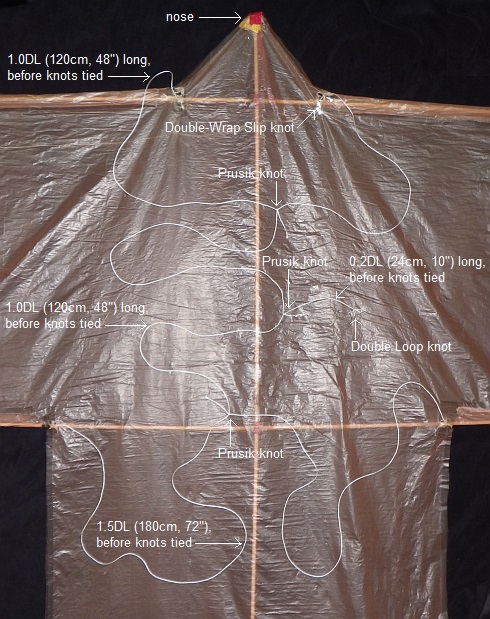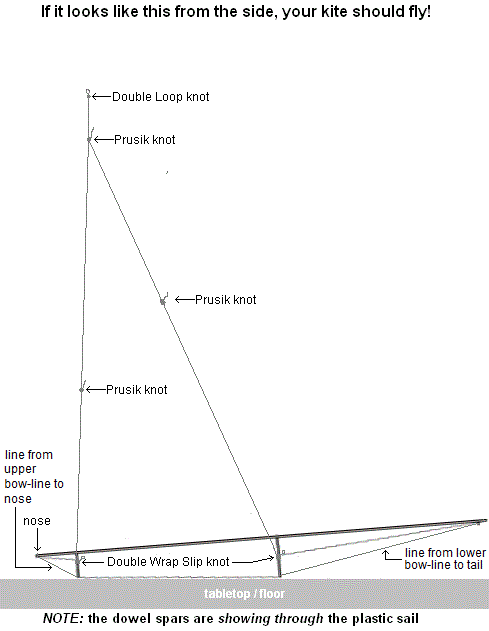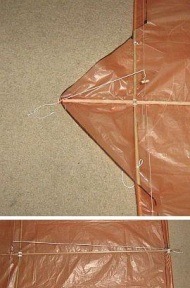- Home Page
- Better Kites
- ... Sode Kite
How to Make a Sode Kite
Step by Step—Page 3 of 4
The MBK Dowel Sode
How to Make a Sode Kite
Bridle
Dacron line in 50-pound strength is ideal for these Dowel Series kites.
All the construction details for the bridle are contained in the large photo below. Look and read carefully, and you can't go wrong on this rather important bit!
KNOTS
If you are new to this, you might need instructions on how to tie the following knots:
Loop knot
Double-Wrap Slip knot
Prusik knot
TIP: Secure the slip knots onto the dowels with enough wood glue to ensure the knots can never slip along the dowel. They won't loosen either.

ADJUSTMENT
Once your kite and bridle looks like the photo up there:
Hold the short bridle line up so all the bridle lines are straight, with the kite laying flat on the table or floor.
Make sure the Prusik knots closest to the kite are adjusted to the middle—right over the vertical spar.
Referring to the diagram below, shift the highest Prusik knot to the shown position. It's not necessarily the perfect
position for your individual kite, but it should at least fly on the
first attempt! Later, you can experiment with shifting the position towards or away from the nose, a little at a time, to improve how high your kite flies.

How to Make a Sode Kite
Nose and Tail Loops
To keep the bowed horizontal spars from flopping back down to the sail, they need to be tethered with short loops of flying line. These can be seen in the diagram above, near the tabletop.
First, let's look at the upper horizontal spar:

- Make a big loop from a length of flying line by tying the two ends into a Multi-Strand Simple knot. The loop should stretch from the center of the upper bow line to the top of the vertical spar, with plenty of length to spare so you can tie it off. See the top photo.
- Attach the loop with a Lark's Head knot to the bow line, directly over the vertical spar or close to it.
- Wrap the other end of the loop around the corner strap a couple of times, and tie off with a single Half Hitch so it's easy to undo.
- Make another loop for the tail end of the kite. The loop should stretch from the center of the lower bow line to the bottom shoelace tie on the vertical spar. See the bottom photo.
- Attach the loop with a Lark's Head knot to the bow line, directly over the vertical spar or close to it.
- Simply place the other end of the loop over the tip of the vertical spar so it slips back up to where the shoelace tie is. If the length is a little too long, just tie another Simple knot near the first one until you get the length right.
Note: These loops stay attached to the bow lines from now on.
At this point, you've pretty much finished making the Dowel Sode! However, there is a short setup procedure to go through before it will fly.
As mentioned earlier, there's more kite making on this site than you can poke a stick at. :-)
Want to know the most convenient way of using it all?
The Big MBK E-book Bundle is a collection of downloads—printable PDF files which provide step-by-step instructions for many kites large and small.
That's every kite in every MBK series.
